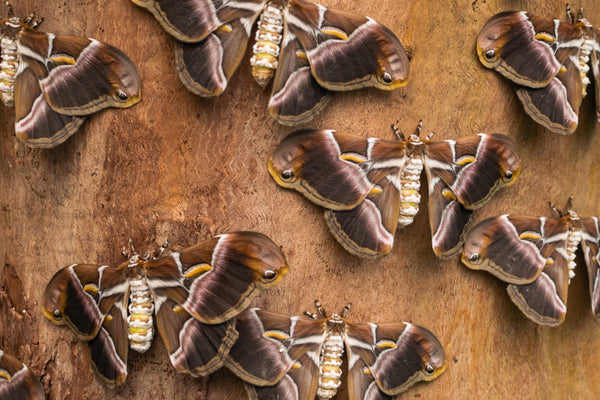Know Your Fiber: Eri Silk
Posted on July 02 2021

Eri silk comes from the ailanthus moth (Samia cynthia ricini), a native to South Asia, and is one of only two domesticated species of silk moths in the world. It is especially fun to work with because it is a staple fiber, unlike other silks such as Tussah, Muga, or Mulberry, which are reeled from silkworm cocoons in a continuous strand. This means that, like wool, Eri fiber comes in shorter lengths that must be carded before being spun. This type of fiber creates a yarn with more open space between fibers than other silk, making a fabric that is very breathable but still retains the characteristic sheen of silk.
The history of Eri silk is, to date, not well established. Archeological studies have some evidence that silk was harvested from wild Eri moths during the Indus Valley Civilization; it would have been one species among many that were harvested for their silk. Given that remains of Eri silk have been found and carbon dated to between 2450 BCE and 2000 BCE, is likely that Eri silk from wild moths has been harvested and used for millennia by people living in South Asia. However, it appears that it only really caught on in Europe during the British Raj period of India’s history, when Great Britain took governance of India. With the sudden increase in trade from India via newly established trade companies such as the East India Company, wild harvested Eri silk caught the attention of the British as a possible luxury trade item. During the latter part of the 1800s, it began to appear in catalogs and dictionaries of Indian products more and more often, as companies tried to figure out if they might be able to make a profit trading Eri silk overseas.
Because there is a lack of written documentation or physical evidence, it is hard to say when Eri moths began to be domesticated. They were certainly well established as a domesticated species by at least the 1990s when Kusuma Rajaiah created and popularized the technique of harvesting Ahimsa silk, also popularly known as Peace Silk. What is Ahimsa silk, you ask? Eri months leave their cocoon in a way that other silk moths do not. Once they are ready to exit their cocoon, they do so through a little hole in the bottom of it, leaving the rest of the cocoon intact. This is different from other silk moths, who destroy their cocoons on the way out. To collect silk from non-Eri cocoons, they need to be boiled with the larvae still in them to harvest the silk. Kusuma Rajaiah’s method for Ahimsa silk requires that the moths leave the cocoons on their own, and that they not be killed. This makes Ahimsa silk quite popular among people whose religion or personal beliefs require them to not harm animals.
Interestingly, much of the Eri silk sold in the west is advertised as Ahimsa silk, under the assumption that all Eri silk is Ahimsa, and produced without killing the moths. However, this is not the case. In northeastern India, Eri moths are reared for both their silk and as a food source. Dishes such as Niang Ryndia Tham Tungtap (Eri silkworm chutney with crabs) and Niang Ryndia Nei-iong bad Lungseij (an Eri silkworm curry with black sesame and bamboos shoots) are popular, and Eri silkworms, sans cocoons, are sold by the kilo in food markets. Then the cocoons are processed for their silk. So, unless the person you are buying Eri from, 1) knows the primary supplier or farmer from whom they are buying Eri silk, and 2) that company or farmer has confirmed that it is Ahimsa silk, it is probable that your Eri silk is not, in fact, Ahimsa silk.
Eri silk comes in two natural colors: White Eri and Red Eri. White Eri is a lovely milky-white and Red Eri glows with a reddish-orange color. How do these two entirely different colors come about? Well, Eri silk moths fed on their usual food, castor leaves, already produce a range of cocoon colors, from white to, to gold, to red. However, if you feed Eri silkworms a particular species of ficus leaves (ficus citrifolia), the number of reddish-orange silk cocoon increases. These cocoons are separated from the white and processed separately, producing the unique and very beautiful Red Eri silk.
Today, raising Eri moths is mostly the domain of remote farmers in places like northeastern India and rural Thailand. The trade has been exceptionally good for tribal women, who can receive training through government programs on how to rear Eri moths and harvest the silk. Eri silk makes up around 8% of the total silk production in India and continues to make inroads into the fashion and textile industries. Not to mention yarn shops like Northwest Yarns.
Eri silk is a very comfortable fiber to wear, even in warm weather. Plus, it is a hypoallergenic fiber, making it perfect for people who cannot wear wool due to lanolin allergies. Eri silk has a staple length of around 4-8 inches. The fiber width can be from 13-17 microns, allowing it to be spun both into extremely fine yarn perfect for a lace project. However, it also makes a lovely heavier yarn that makes for incredibly cozy clothing. Many spinners like to blend their fine wools with Eri silk for a particularly luxurious wool/silk blend.
Ready to try out some Eri silk? We have both White Eri and Red Eri top direct from northeastern India, all ready for your next project. Stop by the shop or drop in and buy some online. We look forward to seeing what you make!


Follow US